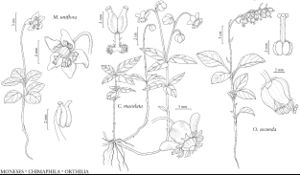Difference between revisions of "Chimaphila"
Fl. Amer. Sept. 1: 279, 300. 1813 ,.
FNA>Volume Importer |
imported>Volume Importer |
||
| (6 intermediate revisions by 2 users not shown) | |||
| Line 22: | Line 22: | ||
|distribution=North America;Mexico;West Indies (Hispaniola);Central America;Eurasia. | |distribution=North America;Mexico;West Indies (Hispaniola);Central America;Eurasia. | ||
|discussion=<p>Species 5 (3 in the flora).</p><!-- | |discussion=<p>Species 5 (3 in the flora).</p><!-- | ||
| − | --><p>Ethnobotanical studies have documented a wide variety of drug and food uses of Chimaphila among more than two dozen tribes of Native Americans (D. E. Moerman 1998; K. Sheth et al. 1967).</p> | + | --><p>Ethnobotanical studies have documented a wide variety of drug and food uses of <i>Chimaphila</i> among more than two dozen tribes of Native Americans (D. E. Moerman 1998; K. Sheth et al. 1967).</p> |
|tables= | |tables= | ||
|references={{Treatment/Reference | |references={{Treatment/Reference | ||
| Line 67: | Line 67: | ||
|family=Ericaceae | |family=Ericaceae | ||
|illustrator=Barbara Alongi | |illustrator=Barbara Alongi | ||
| + | |illustration copyright=Flora of North America Association | ||
|distribution=North America;Mexico;West Indies (Hispaniola);Central America;Eurasia. | |distribution=North America;Mexico;West Indies (Hispaniola);Central America;Eurasia. | ||
|reference=standley1988a;takahashi1986b | |reference=standley1988a;takahashi1986b | ||
| Line 72: | Line 73: | ||
|publication year= | |publication year= | ||
|special status= | |special status= | ||
| − | |source xml=https:// | + | |source xml=https://bitbucket.org/aafc-mbb/fna-data-curation/src/2e0870ddd59836b60bcf96646a41e87ea5a5943a/coarse_grained_fna_xml/V8/V8_727.xml |
|subfamily=Ericaceae subfam. Monotropoideae | |subfamily=Ericaceae subfam. Monotropoideae | ||
|genus=Chimaphila | |genus=Chimaphila | ||
Latest revision as of 22:45, 5 November 2020
Subshrubs, chlorophyllous, autotrophic. Stems erect, rarely decumbent, glabrous or papillose to hispidulous, especially distally. Leaves cauline, alternate or pseudoverticillate in 2–5(–6) whorls; petiole present; blade maculate or not, lanceolate, elliptic-lanceolate, ovate-lanceolate, oblong-lanceolate, ovate, lanceolate-oblong, oblanceolate, elliptic, or spatulate, coriaceous, margins entire, serrulate, serrate, or crenate-serrate, revolute, surfaces glabrous or papillose. Inflorescences corymbs or subumbels, rarely solitary flowers, not lax in bud or flower, erect in fruit, (symmetric); peduncular bracts absent; inflorescence bracts adnate to pedicels, sometimes scarcely so. Pedicels erect in fruit, (glabrous or papillose to hispidulous); bracteoles absent. Flowers radially symmetric, nodding or spreading; sepals 5, connate proximally, often obscurely so, calyx lobes ovate, broadly ovate, or suborbiculate; petals 5, distinct, white, pink, or rose, often tinged violet, without basal tubercles, (surfaces glabrous), corolla rotate to crateriform or broadly crateriform; intrastaminal nectary disc present; stamens 10, included; filaments broad proximally, abruptly narrowed medially, slender distally, dilated basal portions ciliate or villous to densely villous; anthers oblong, without awns, with tubules, dehiscent by 2 crescent-shaped to round pores; pistil 5-carpellate; ovary imperfectly 5-locular; placentation intruded-parietal; style (included), straight, expanded distally; stigma entire or obscurely 5-ridged, without subtending ring of hairs. Fruits capsular, erect, dehiscence loculicidal, no cobwebby tissue exposed by splitting valves at dehiscence. Seeds ca. 1000, fusiform, winged. x = 13.
Distribution
North America, Mexico, West Indies (Hispaniola), Central America, Eurasia.
Discussion
Species 5 (3 in the flora).
Ethnobotanical studies have documented a wide variety of drug and food uses of Chimaphila among more than two dozen tribes of Native Americans (D. E. Moerman 1998; K. Sheth et al. 1967).
Selected References
Lower Taxa
Key
| 1 | Inflorescence bracts broadly ovate to broadly obovate; inflorescences 1-3-flowered; calyx lobes (3-)5-6.5 mm; stigmas 1.6-2.2(-2.8) mm wide. | Chimaphila menziesii |
| 1 | Inflorescence bracts acicular to linear-lanceolate; inflorescences (1-)2-7-flowered; calyx lobes 1-4.1 mm; stigmas 2-4 mm wide | > 2 |
| 2 | Leaf blades maculate; dilated basal portions of filaments densely villous. | Chimaphila maculata |
| 2 | Leaf blades not maculate; dilated basal portions of filaments ciliate | Chimaphila umbellata |
